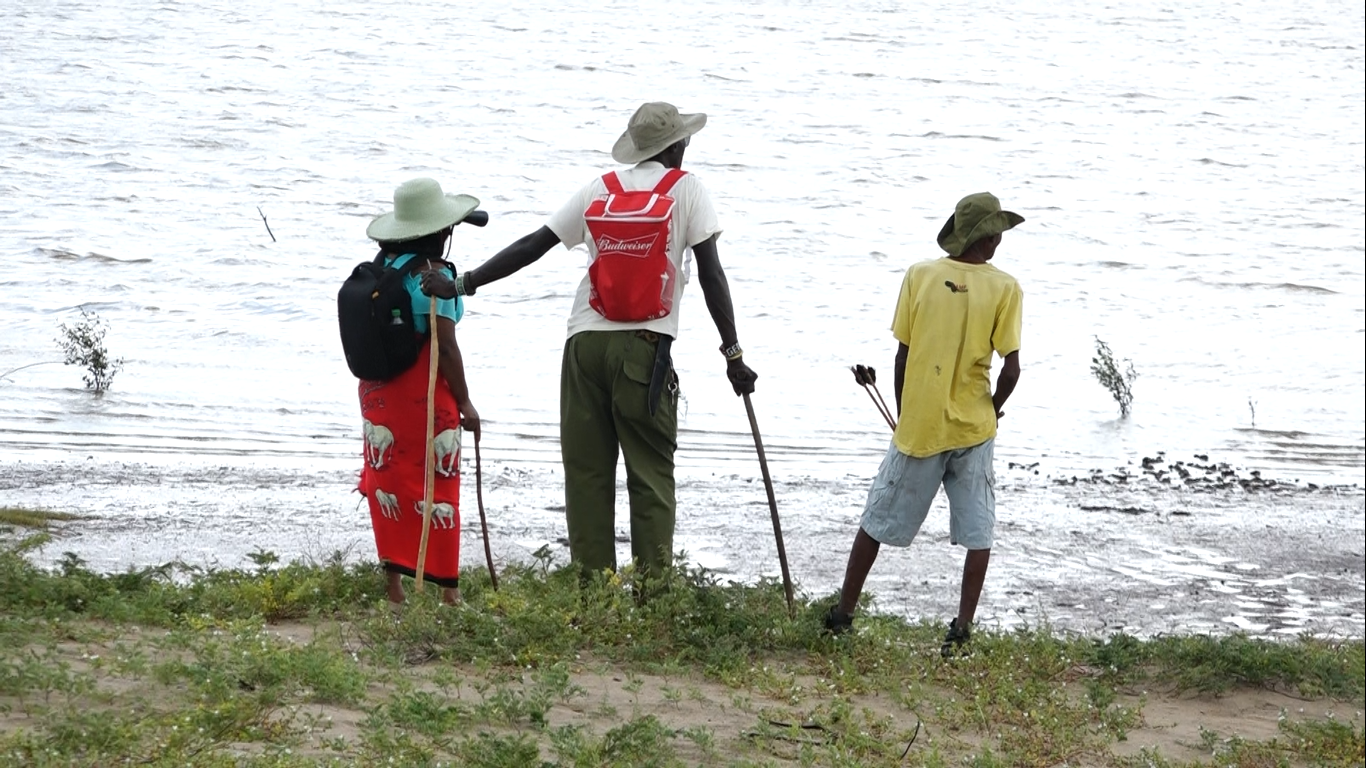In the enchanting realm of Coastal Kenya, where the sun kisses the horizon and the rhythm of life dances to the ebb and flow of the tides, a tale of profound transformation unfolds—a tale of rising sea levels, shifting landscapes, and a community’s unyielding spirit in the face of climate change.
As the sun sets over the Indian Ocean, whispers of change drift through the serene coastal landscapes.
At the heart of this narrative stands Dr. Mohammed Omar, a scientific researcher at the Wildlife Research and Training Institute (WRTI).
“The dynamic interaction between the ocean and the land has undergone a significant and noticeable shift,” he notes, gazing intently at the horizon.
His observation unveils the complex connections between rising sea levels and the coastal habitat. He emphasizes the gradual recession of submerged seagrass meadows, crucial nurseries for a diverse marine array, due to heightened inundation.
Erosion is increasingly concerning for Coastal Kenya, worsened by rising tides that amplify the impact of wave energy moving inland, as Dr. Omar highlights in his conversation with Kass Media Group. This phenomenon underscores a broader regional challenge: the encroachment of riparian lands for development.
‘The shoreline is dynamic; it was never meant to remain constant. Coastal erosion, a natural part of Earth’s cycle due to the force of strong waves, is compounded by increased encroachment into the riparian zone. This redirection of water’s natural flow does result in erosion, affecting the delicate coastal balance.”
Central to Coastal Kenya’s resilience in the face of these challenges are the individual experiences of its dedicated guardians. Among them is Tracey Russell, a member of Turtle Beach Jumba, an independent turtle conservation group.
Their mission revolves around safeguarding the sea turtles that journey to lay eggs on the age-old shores of Jumba la Mtwana Beach—a hallowed site where green sea turtles have nested for countless generations.
These remarkable creatures undertake an extensive pilgrimage to return to their ancestral haven and ensure the continuation of their legacy.
“Typically, turtle nesting transpires along this stretch of Jumba Beach,” Tracey estimates, recalling recent hatchlings numbering between 100 and 140. “At this moment, nests are present, and our focus is on releasing the hatchlings as soon as possible.”
Tracey explains that shifting tides alter shoreline dimensions, slopes, and beach profiles. These changes affect the suitability of nesting sites for sea turtles. This issue compounds the challenges faced by these already endangered sea creatures.
She stresses the need to keep nesting sites undisclosed, protecting them from poachers who raid nests and slaughter turtles for meat.
“While turtle poaching carries legal penalties, sadly, it has failed to discourage offenders from targeting the critically endangered green turtle,” she laments.
Tracey’s commitment reflects the essence of Coastal Kenya, where the pursuit of conservation is entwined with the challenges of a shifting environment.
Within this captivating coastal landscape, where sea turtles find their nesting sanctuary, another remarkable spectacle unfolds. Majestic Sabaki hippos, found in Kilifi, embark on unique journeys from lush forests to the water’s edge where the river converges with the ocean. These gentle giants seek sustenance in forested domains and return gracefully to the water’s embrace.
Amidst this scenic beauty, Kene Kiplagat, chairman of Camp Gedeng, a local community group dedicated to protecting the coastal environment at Sabaki Estuary, Kilifi County, emphasizes the critical challenges. “Higher tides and encroaching seawater put coastal wetlands at risk,” he warns.
According to Kene, these wetland areas, where the river meets the ocean, are delicate ecosystems providing critical habitats for diverse vegetation and wildlife.
“The changes in water levels and saltwater intrusion due to rising tides can profoundly impact these ecosystems, affecting delicate balance and threatening the rich biodiversity they support,” Kene further notes, adding that the Sabaki estuary serves as a haven for an array of bird species, including rare varieties and impressive gatherings of gulls and terns.
“These birds venture far into the sea for sustenance before returning to roost on sandbanks,” he explains.
The estuary of the river flows into the vast expanse of the Indian Ocean, encompassing stretches of sand dunes, pristine beaches, and both seasonal and permanent wetlands on either side. Along parts of the river’s course, mangrove forests thrive, contributing to the complex ecosystem.
As a flock of birds takes to the sky, forming intriguing patterns that captivate the observer, Kene points out, “Engaging in birdwatching is a pedestrian activity, with the highest bird diversity usually observed during migration seasons, much like this eighth month of the year.”
The Global wetlands outlook, from the Ramsar Convention delivers a stark warning: our planet’s vital wetland ecosystems are vanishing at an alarming rate. A staggering 87% of wetlands have been lost since 1700, and a significant 35% has vanished since 1970. This rapid loss places wetland-dependent species on the brink of extinction. The imperative for immediate action to halt this decline cannot be overstated, as the far-reaching repercussions extend well beyond the wetlands themselves.
Furthermore, the Intergovernmental Panel on Climate Change (IPCC) warns that without urgent global action, sea levels are going to continue to rise for many centuries to come. This presents an increasing danger to communities living in coastal areas.
Kene underscores that “During the previous year’s severe dry season, the hippos faced a scarcity of grazing land, with many becoming emaciated. To ensure a source of sustenance, we initiated a project to lay hay along their route,” he said.
But amidst challenges, a glimmer of hope emerges. As the day unfolds its golden embrace, Peter Mataza emerges—a youthful emblem of the sea’s bounty, holding onto his day’s catch. His voice, brimming with admiration, praises the value of mangroves in holding food for sea life, preserving these waters.
He notes that “a healthy sea means we can bring in a good catch and have enough to eat.
Mataza’s voice urgently underscores the imperative of preserving the natural wonders of the coastal area, highlighting the diverse impacts of climate change on individuals.
For Mataza and his family, their survival is closely linked to a thriving natural world for food and income.
As we navigate the intricate tapestry of Coastal Kenya’s evolving landscape, the voices of its people take center stage. A symphony of determination, resilience, and hope resounds through the stories of Kene, Tracey, Dr. Omar, and others who stand as beacons of inspiration along the shoreline.
In every ripple, footprint, and heartbeat, the indomitable spirit of Coastal Kenya radiates as an enduring testament to the powerful alliance of community, science, and unwavering resolve against the relentless tide of climate change.





